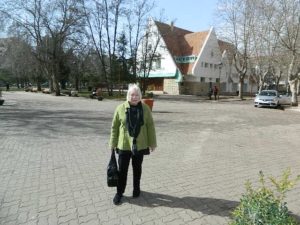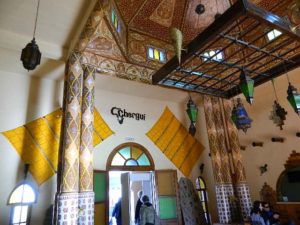 We’re headed for the desert — the ‘real’ Morocco. But first it’s over the Atlas Mountains. We climb through foggy forests of Atlas cedars through snow fields — not something I expected to see in Morocco.
We’re headed for the desert — the ‘real’ Morocco. But first it’s over the Atlas Mountains. We climb through foggy forests of Atlas cedars through snow fields — not something I expected to see in Morocco.
Ifrane is another surprise. We make a cafe stop in what appears to be an upscale Alpine resort. It was built by the French in the 1930s (most of Morocco had been theirs since 1912).  Today it’s where wealthy Moroccans come to ski in the winter and escape summer’s heat.
Today it’s where wealthy Moroccans come to ski in the winter and escape summer’s heat.
Morocco is skinny and long, starting on the shores of the Mediterranean, arcing South and East along the rim of the Atlantic, ending in a disputed border deep into the continent. The mountains are its spine, snaking down its middle, dividing the country, not only geographically. As we descend, we leave behind the well watered coast, the French influenced cities, the Western dressed citizens. Every hairpin turn takes us closer to the austerity of the desert, to people dressed to protect from its heat, to different ethnic majorities, to societies that still retain ancient tradition. To Berber country
They’re more properly called the Amazigh, meaning free people. It was the Romans who named them Berbers — barbarians. The name stuck. So did anti-Amazigh prejudice. These indigenous Moroccans, who make up 60% of today’s population, trace their history back 7000 years, long before the Arab invasion in the 7th century that brought with it a dominant alien culture. Times are changing, though, as the Amazigh assert political power and gain access to equal resources.
 After a stop at our first date palm oasis — and purchase of the sticky sweets, of course — we head for Erfoud and the Kasbah Hotel Chergui. Dinner features madfouna, a calzone style dough pocket stuffed with minced onions and herb-spiked lamb, baked until golden and puffy.
After a stop at our first date palm oasis — and purchase of the sticky sweets, of course — we head for Erfoud and the Kasbah Hotel Chergui. Dinner features madfouna, a calzone style dough pocket stuffed with minced onions and herb-spiked lamb, baked until golden and puffy.
 And after dinner, a performance of Malhoun music — AD534B72-7774-4945-8671-E2E32DC95BE1 — known as sung poetry. Click above to have a listen.
And after dinner, a performance of Malhoun music — AD534B72-7774-4945-8671-E2E32DC95BE1 — known as sung poetry. Click above to have a listen.
An early night tonight. Tomorrow it’s into the desert.

Fascinating stuff, Sharon. I am particularly intrigued by the Amazigh: their long history, their tenacity, & their plight.
Thanks, Charlie. These issues still exist even after more than 1000 years of living ‘together.’Still, they’re making progress now == and talking openly about it for the first time.